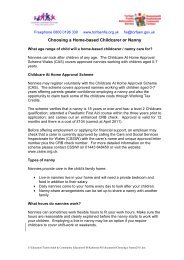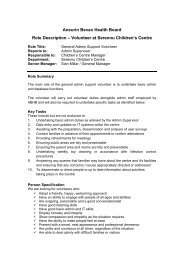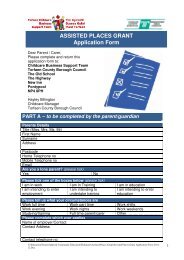Food and Health Guidelines - Torfaen Family Information Service
Food and Health Guidelines - Torfaen Family Information Service
Food and Health Guidelines - Torfaen Family Information Service
Create successful ePaper yourself
Turn your PDF publications into a flip-book with our unique Google optimized e-Paper software.
6. Menu Planning<br />
Involving children <strong>and</strong><br />
parents in planning<br />
menus<br />
When planning menus it is good practice to<br />
discuss the food likes <strong>and</strong> dislikes of children<br />
with parents so that the menu plan can<br />
be altered accordingly. Children’s cultural<br />
background has to be respected <strong>and</strong> any<br />
special dietary requirements should be taken<br />
into account.<br />
Children should be encouraged to try<br />
different food tastes on a regular basis.<br />
However, they may not accept meals<br />
containing too many different or new flavours<br />
so try <strong>and</strong> introduce new tastes to your menu,<br />
one at a time.<br />
If children have made suggestions for the<br />
menu it will give them a sense of pride <strong>and</strong><br />
may also encourage them to eat.<br />
<strong>Health</strong>y cooking guidelines<br />
• Home-made dishes will generally be<br />
healthier than ready meals because you<br />
can select your ingredients carefully <strong>and</strong><br />
the salt content is likely to be lower.<br />
• Uses of salt - avoid adding salt in cooking<br />
<strong>and</strong> at the table. Restrict the use of packet<br />
soups, stock cubes, packet sauces <strong>and</strong><br />
other processed foods as they often have<br />
a high salt content. A high salt intake is<br />
linked to high blood pressure later on<br />
in life.<br />
• Use of fats - use monounsaturated<br />
oils (rapeseed/canola/olive) or<br />
polyunsaturated oils (sunflower/ safflower)<br />
in cooking, but try not to fry foods more<br />
than once a week. Bake or grill rather than<br />
frying or roasting.<br />
Purchasing <strong>Food</strong> Ingredients<br />
Getting a balance between ‘value for<br />
money’ <strong>and</strong> providing ‘quality’ food<br />
can be a challenge. When buying food<br />
consider the following:<br />
• Pasta, rice <strong>and</strong> bread are economical;<br />
as are eggs, pulses <strong>and</strong> tinned fish.<br />
Lean meat is often better value than<br />
cheaper fattier varieties.<br />
• Check the list of ingredients - the longer<br />
the list, the poorer the quality in general.<br />
• The ingredient list on food labels starts<br />
with the main ingredient <strong>and</strong> is in<br />
weight order.<br />
• Compare foods <strong>and</strong> choose those that<br />
are lower in salt or sugar.<br />
• If salt, sugar, or additives come high on<br />
the list it may be best to avoid.<br />
• ‘Value food’ may not be good value if<br />
it is not acceptable to children or not<br />
good nutritionally.<br />
• Sugar may appear on labels under<br />
different names: sucrose, maltose,<br />
lactose, dextrose, fructose, glucose,<br />
glucose syrup, xylitol, sorbitol, mannitol,<br />
raw sugar, brown sugar, molasses,<br />
<strong>and</strong> honey.<br />
For advice on underst<strong>and</strong>ing food labels<br />
refer to the leaflet, ‘<strong>Food</strong> using traffic<br />
lights to make healthier choices’.<br />
(See section 10)<br />
• Trim visible fat from meat <strong>and</strong> skin from<br />
poultry before cooking.<br />
7

















